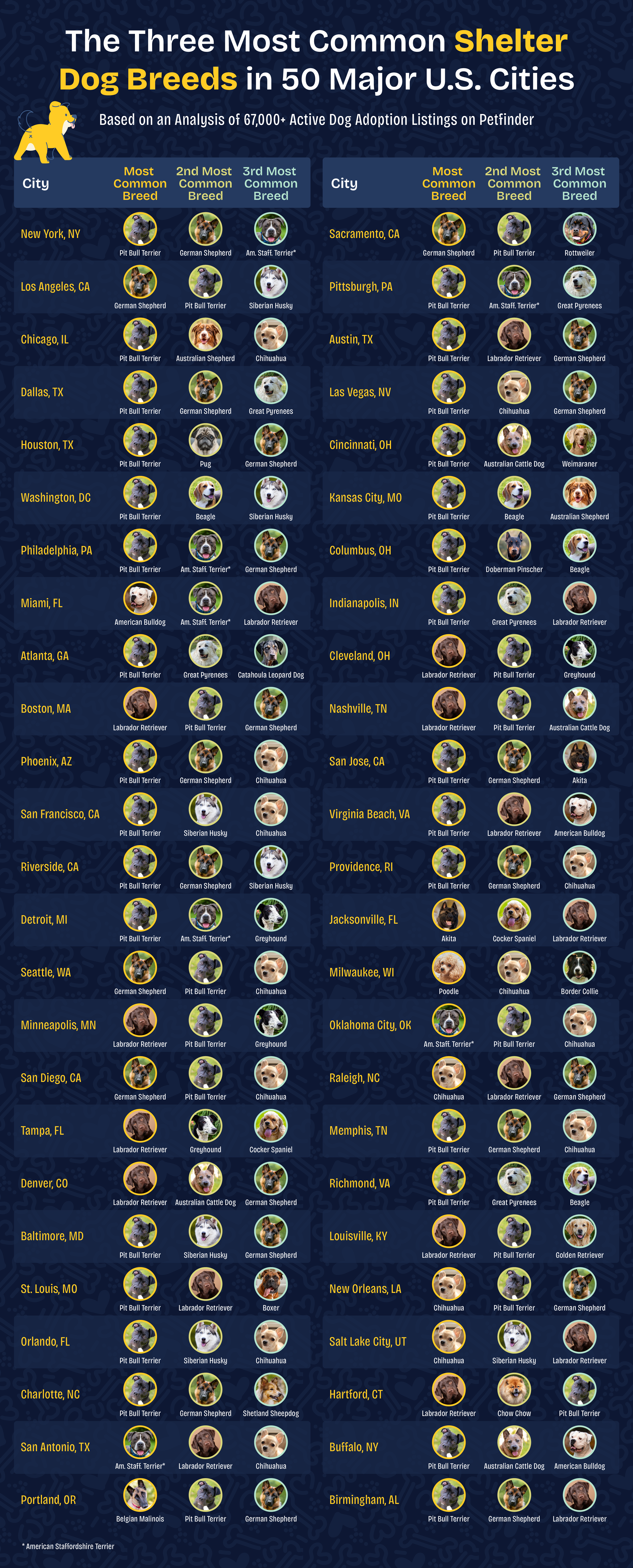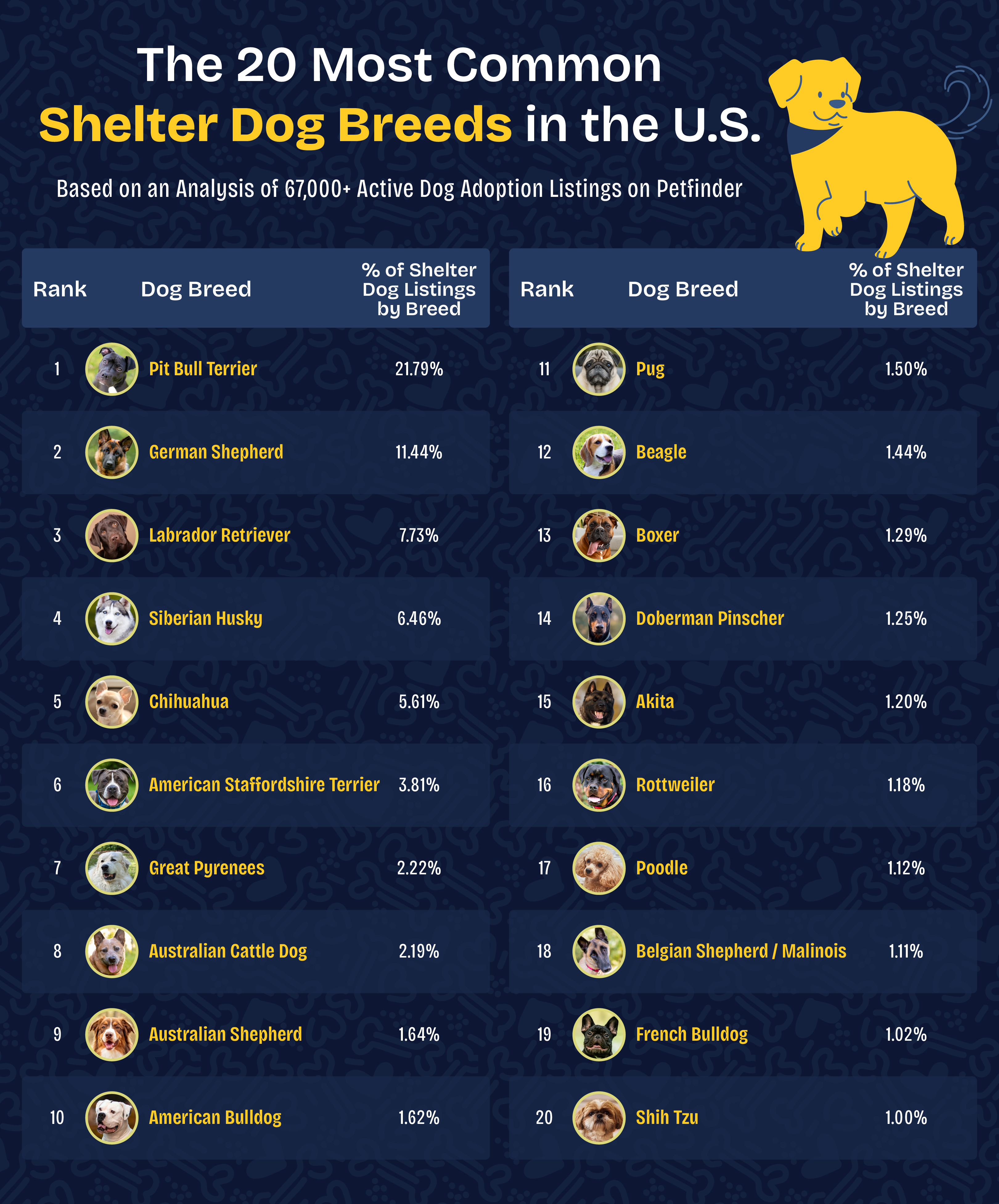The Most Common Shelter Dog Breeds in Every Major U.S. City

Animal shelters across the U.S. are sounding the alarm as more dogs arrive and fewer are adopted. Overcrowded shelters, housing challenges, and post‑pandemic surrenders are leaving some pets waiting weeks or even months for a home. And the breeds most often in need — and how long they wait — can vary dramatically from city to city.
So, which dog breeds are filling shelters in America’s metro areas? To find out, we analyzed more than 67,000 dog adoption listings on Petfinder from shelters and rescues across the 50 largest U.S. cities. We identified the three most common shelter dog breeds in each city, the most common shelter breeds nationwide, and the percentage of dogs that had been listed for adoption for 30 days or longer. This approach allowed us to see not only which breeds are most often in need of homes, but also which cities are quickly finding new homes for dogs, and which ones may be facing longer adoption timelines.
Key Findings
- The Pit Bull Terrier is the most common dog breed in shelters across America’s largest cities, accounting for nearly 22% of all dog adoption listings in our study.
- The next most common shelter breeds are German Shepherds (11.4%), Labrador Retrievers (7.7%), Siberian Huskies (6.5%), and Chihuahuas (5.6%).
- Adoption timelines vary sharply by region. In Dallas, TX, 85.9% of dogs have been listed for 30 days or longer, while in Cleveland, OH, that number drops to just 41.8%.
The Most Common Shelter Dog Breeds in the 50 Largest U.S. Cities

The dogs filling America’s shelters look different depending on where you live — and in the country’s largest cities, those differences are striking. In Los Angeles, the most common shelter dog breed is the German Shepherd — a loyal, intelligent companion that also needs plenty of space, exercise, and engagement to thrive. In Miami, shelters most often house American Bulldogs — big‑hearted, sun‑loving dogs that do best with attentive, experienced owners.
Some cities see more large, high‑energy working breeds, while others have an influx of smaller companions. Chicago and Denver both have Australian Shepherds and Australian Cattle Dogs near the top of their lists, energetic herding dogs that flourish when they have a job to do. In places like New Orleans, Raleigh, NC, and Salt Lake City, it’s Chihuahuas that dominate shelter rosters. And in Cleveland and Tampa, you’ll spot Greyhounds among the most common shelter breeds, perhaps tied to adoption pipelines from the racing world.
Siberian Huskies show up often in shelters in warmer cities like Los Angeles, Riverside, CA, and Orlando. Their need for constant exercise and thick double coats can make them challenging for first‑time dog owners in warmer climates.
Some findings were unexpected. Milwaukee was the only city in the study where Poodles were the most frequently found breed in shelters and rescues, and it was also the only place where Border Collies appeared among the most common. Louisville, KY, was the only city where Golden Retrievers were among the most common breeds in shelters. In many communities, Goldens rarely remain in shelters for long; when they do arrive, they’re often adopted quickly due to strong demand by families.
The Most Common Dog Breeds in U.S. Shelters and Rescues

The five most common dog breeds found in U.S. shelters and rescues are:
- Pit Bull Terrier – 21.8% of dog adoption listings
- German Shepherd – 11.4%
- Labrador Retriever – 7.7%
- Siberian Husky – 6.5%
- Chihuahua – 5.6%
Pit Bull Terriers account for nearly 22% of all dogs listed in shelters and rescues, making them the single most common breed in need of new homes across America’s largest cities. They are the most frequently found shelter breed in 29 of the 50 cities we analyzed, including nearby Dallas. Pit bulls are individuals, not a stereotype, yet they remain one of the most at‑risk shelter animals, according to PetMD. Unfortunately, breed‑specific legislation, housing restrictions, and negative stereotypes often work against Pit Bulls, making it harder for families to adopt them.
German Shepherds take the number‑two spot, making up 11.4% of shelter listings. They are the most common shelter breed in four of the 50 cities analyzed — Los Angeles, Sacramento, San Diego, and Seattle. Labrador Retrievers, at 7.7%, are famously friendly and adaptable, but even the most beloved breeds can find themselves in shelters across the country. They are the most frequently found shelter breed in eight of the 50 cities considered in our study, including Boston, Cleveland, Denver, Minneapolis, Nashville, and Tampa.
Siberian Huskies, making up 6.5% of shelter dogs, are striking and charismatic but bred for endurance in cold climates, which can make them a tricky fit in many homes, especially warmer ones. Chihuahuas, at 5.6%, thrive in smaller living spaces but can be surrendered due to behavioral misunderstandings or overbreeding in certain regions.
Rounding out the top 10 are breeds like Great Pyrenees (2.22%), Australian Cattle Dogs (2.19%), Australian Shepherds (1.64%), and American Bulldogs (1.62%).
American Staffordshire Terriers (#6), at 3.8%, Doberman Pinschers (#14), and Rottweilers (#16) can face many of the same adoption hurdles as Pit Bulls due to similar breed stigma and housing restrictions. These barriers can keep well‑behaved, loving dogs in shelters longer, not because of their temperament, but because of misconceptions and rules that limit where they can live.
U.S. Cities Where Dogs Wait Longer to Be Adopted
In addition to looking at the most common shelter breeds in 50 of the largest U.S. cities, we also analyzed Petfinder data to see what percentage of dogs have been listed for adoption for 30 days or more.
Here are the five cities where the most dogs wait 30+ days to be adopted:
- Dallas, TX – 85.9%
- Austin, TX – 75.2%
- Oklahoma City, OK – 74.2%
- Miami, FL – 70.1%
- San Diego, CA – 68.6%
There’s a clear cluster in the South Central states of Texas and Oklahoma: Dallas, Austin, and Oklahoma City all have more than 74% of their dog listings sitting on Petfinder for a month or more. Texas is especially notable, with three cities in the top 10 for slower adoption timelines (Dallas, Austin, and San Antonio). Florida also stands out, with two cities in the top 10 — Miami and Jacksonville — where 70.1% and 66.6% of dogs have been waiting for 30 days or more, respectively.
Why might adoption timelines be longer in Texas and Florida? High shelter intake is one factor; both states struggle with large stray dog populations, partly due to warmer climates allowing dogs to survive outside year‑round. Overcrowding in municipal shelters can also slow down adoptions when the sheer volume of available dogs overwhelms potential adopters.
On the opposite end, here are the five cities where the fewest dogs wait 30+ days to be adopted:
- Cleveland, OH – 41.8%
- Boston, MA – 45.4%
- New Orleans, LA – 46.2%
- Portland, OR – 47.1%
- Denver, CO – 47.3%
Shorter adoption timelines in these cities could be linked to a few factors. In places like Boston, Portland, and Denver, strong rescue networks and higher adoption demand can mean dogs find homes quickly, sometimes within days. Other cities may benefit from active community‑based adoption events and strong shelter‑rescue partnerships that move dogs faster through the system.
Closing Thoughts
If there’s one takeaway from this study, it’s that dog shelter populations aren’t one‑size‑fits‑all. The breeds you’re most likely to see depend a lot on where you live, local adoption demand, and the challenges your community’s shelters face. Right now, with intake climbing and many shelters over capacity, understanding these trends isn’t just interesting, it’s a reminder that adoption decisions have real, lasting impact for the dogs who need homes the most.
Hartley Law works with people every day to promote responsible dog ownership. Understanding a dog’s needs, temperament, and history can go a long way toward keeping both pets and people safe. But if you do find yourself in the unfortunate situation of dealing with a dog bite, the team at Hartley Law is here to help you navigate the legal process and understand your options.
Methodology
To identify which dog breeds are most common in U.S. shelters, we analyzed more than 67,000 active dog adoption listings on Petfinder from shelters and rescues in the 50 largest U.S. cities. For each city, we filtered results to include only local pets and used the breed-specific labels provided by the shelters. We then determined the three most common shelter dog breeds in each city, as well as the most common breeds across all 50 cities. Finally, we calculated the percentage of dog listings in each city that had been on Petfinder for 30 days or longer as an indicator of where dogs may be finding homes more quickly or waiting longer to be adopted.











